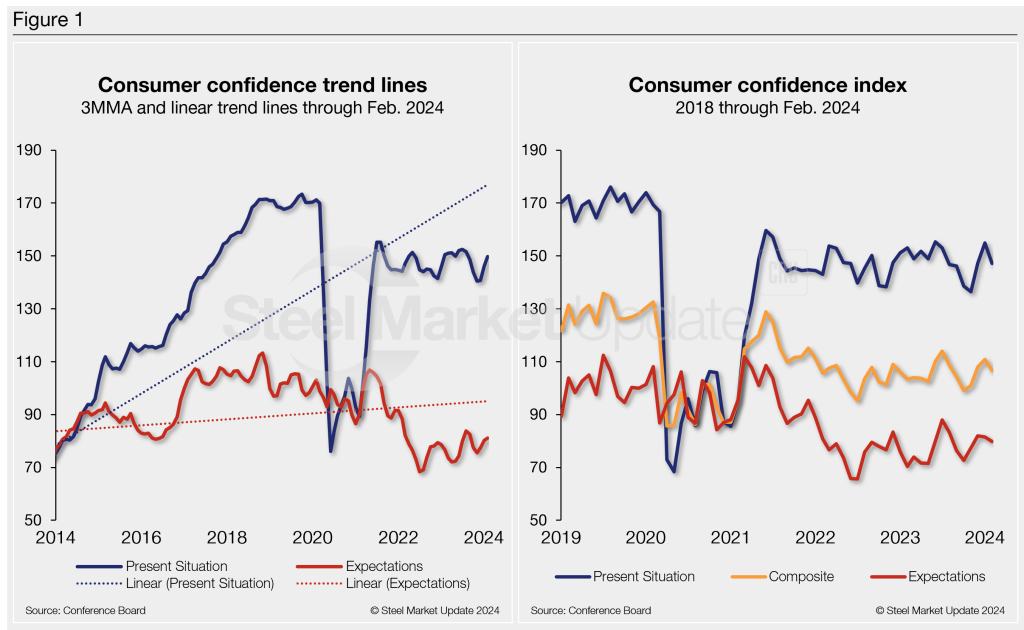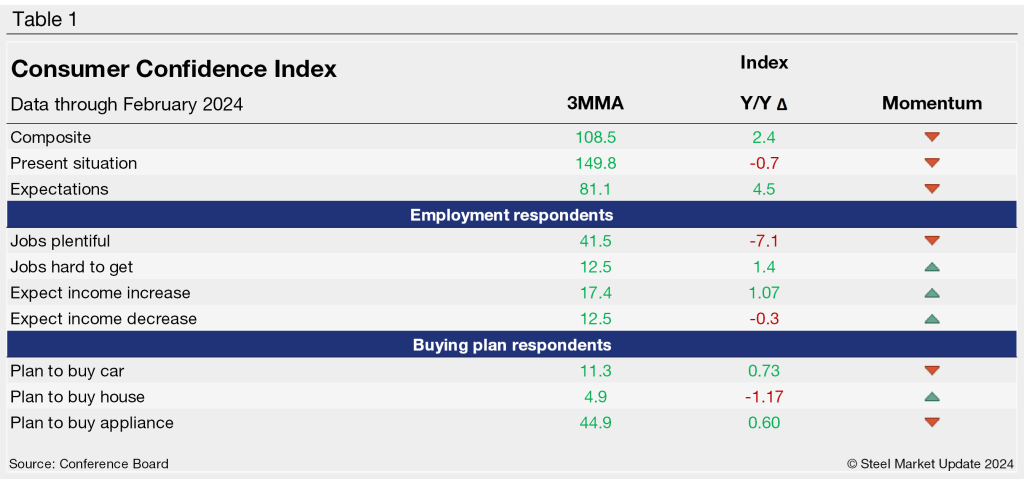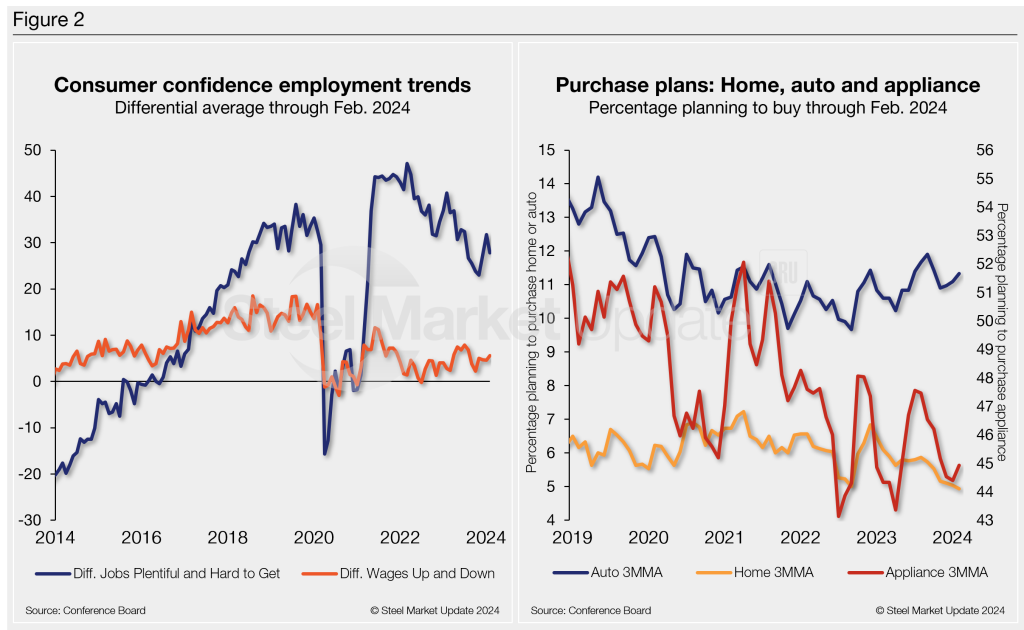Economy

Consumer confidence slipped in February
Written by David Schollaert
March 6, 2024
Consumer confidence in the US declined in February after accelerating to a two-year high the month prior, The Conference Board reported. Results came in amid ongoing concerns regarding the US economy.
The headline Consumer Confidence Index declined to 106.7 in February from a downwardly revised 110.9 in January. The index, which measures Americans’ assessment of current economic conditions, showed somewhat of a surprising result when it came in lower.
Inflation still a major sticking point
While higher interest rates and inflation continue to weigh on consumers, the economy continues to show resilience. Though price growth has slowed significantly in the past year, inflation remains above the Federal Reserve’s 2% target.
Both the Present Situation and the Expectations indices also declined from January. Despite the downgrade in confidence, consumers’ intent to purchase homes, autos, and big-ticket items mostly increased modestly, the report noted.
“The decline in consumer confidence in February interrupted a three-month rise, reflecting persistent uncertainty about the US economy,” said Dana Peterson, The Conference Board’s chief economist. “The drop in confidence was broad-based, affecting all income groups except households earning less than $15,000 and those earning more than $125,000.”
Responses from consumers showed that while they remain principally concerned with overall inflation, they are a “bit less concerned about food and gas prices” Peterson added.
The Present Situation Index, which measures consumer sentiment toward current business and labor market conditions, fell in February, erasing the jump seen the month prior, declining 7.7 points to 147.2. The Expectations Index, which assesses the short-term outlook for income, business, and labor market conditions, also moved lower to 79.8, down 1.7 points from the prior month’s reading.
Headline index 3MMA trend
Calculated as a three-month moving average (3MMA) to smooth out volatility, The Conference Board’s Composite Index was 108.5, a 1.9-point increase vs. January, marking February the third straight month to see an increase.
The Composite Index is made up of two sub-indexes: Consumers’ view of the present situation and their expectations for the future. Figure 1 below notes the 3MMA linear trend lines from January 2014 through February 2024 vs. the trend lines of all three subcomponents of the index: Present Situation, Composite, and Future Expectations. All three were above the average composite line of 94.5 before the pandemic, then fell consecutively through February 2021. A surge from March through June of 2021 pulled all three indexes above the composite line once again. However, economic uncertainty continues to weigh on expectations, keeping them below the average.

The table below compares February 2024 with February 2023 on a 3MMA basis. The headline index and both of its two sub-indexes had been on the rise on a year-over-year (y/y) basis, with the Present Situation showing a bit of a decline. All three indexes are, however, showing a downward momentum, something worth keeping an eye on, as gains continue to temper.
When compared to the same 2019 pre-pandemic period, the Composite Index is still behind by roughly 20 points on a 3MMA basis. The Present Situation is down nearly 25 points, while the Expectations reading is down roughly 17 points this month when compared to the same period in 2019. The Consumer Confidence report includes employment data and purchase plans. These are summarized in the table below.

Business and employment conditions
The present situation slipped in February as “consumers’ views of both business conditions and the employment situation became less favorable,” according to the report as consumers’ concern regarding their financial situation also weakened.
The differential between those finding jobs and those having difficulty was 27.8 in February, down from 31.7 in January and well behind the most recent high of 47.1 set in March 2022. The difference between those expecting wages to rise vs. those expecting wages to decline moved up to 5.6 in February from 4.6 the month prior and was well removed from the recent high of 11.6 in June 2021.
Buying intentions for big-ticket items — cars, homes, and major appliances — were mixed in February. While consumers were slightly more keen to purchase autos and major appliances, they were down on home buying.
These recent dynamics and historical movements are illustrated below in Figure 2.

Note: The Conference Board is a global, independent business membership and research association working in the public interest. The monthly Consumer Confidence Survey®, based on a probability-design random sample, is conducted for The Conference Board by Nielsen. The index is based on 1985 = 100. The composite value of consumer confidence combines the view of the present situation and of expectations for the next six months.

David Schollaert
Read more from David SchollaertLatest in Economy

New York state manufacturing index drops again in April
Firms were pessimistic, with the future general business conditions index falling to its second lowest reading in the more than 20-year history of the survey

Construction adds 13,000 jobs in March
The construction sector added 13,000 jobs, seasonally adjusted, in March, but tariffs could undermine the industry.

Supply chains, end-users brace for impact from tariffs
Supply chains are working through what the tariffs mean for them

ISM: Manufacturing expansion loses steam after two months of growth
US manufacturing activity slowed in March after two straight months of expansion, according to supply executives contributing to the Institute for Supply Management (ISM)’s latest report.

Chicago Business Barometer rose to 16-month high in March
The Chicago Business Barometer increased for the third-consecutive month in March. Despite this, it still reflects contracting business conditions, as it has since December 2023.
